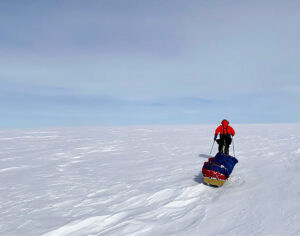Unassisted Solo Traverse
On Boxing Day, 33-year-old Colin O’Brady finished his solo, unassisted, unsupported crossing of Antarctica. The endurance athlete lived up to the moniker, finishing the final 129km in a mammoth 33-hour push.

O’Brady calling home with the good news. The wooden post behind him denotes the start of the Ross Ice Shelf and the end point for the traverse. Photo: Colin O’Brady
O’Brady completed the entire traverse in just over 54 days, winning his informal race with Lou Rudd, 49. Rudd finished his own trek on Friday afternoon, Eastern Time, after 56 days.
During the past week, both men regularly shattered their own daily distance records, thanks to a long downhill descent and likely to the contentious use of the South Pole Overland Traverse road from the South Pole to the Ross Ice Shelf. O’Brady kept his two-day lead through the descent and woke up on Christmas Day with enough energy for a sprint finish.
Throughout, both O’Brady and Rudd resisted the siren song of rest days and pushed on through some horrendous conditions. The pair had little food to spare; warm weather and soft snow en route to the South Pole could have derailed both at the outset. In the end, the much younger O’Brady was able to put in a few extra ultra-long days.
The question remains whether their traverse actually qualifies as unassisted, or even as a full traverse. The graded road that both followed from the South Pole eliminated the sastrugi that would have dramatically slowed them down and further depleted their food and strength. Regular markers along the trail eliminated the need for navigation.
Furthermore, both shortened their route significantly by calling a halt at the beginning of the Ross Ice Shelf: which their famous predecessors from the Golden Age of Antarctic Exploration — and some strong modern travelers — did not. Borge Ousland’s 1996-7 crossing of Antarctica is often called “assisted” because he used a kite part of the way. However, his route covered the entire Ross Ice Shelf and was 1,000km longer than theirs.
O’Brady and Rudd accomplished a mighty trek, but it is unfortunate that neither man admitted that they had chosen to use a road for at least a third of it. However, theirs were not the first expeditions to keep this little Antarctic secret to themselves.

O’Brady’s and Rudd’s route vs Ousland’s. Some polar veterans doubt whether the truncated route qualifies as a full traverse.
Solo to the South Pole

Abe’s progress (red dots). The graph shows distance traveled on the x-axis and altitude on the y-axis. Photo: Masatatsu Abe
Masatatsu Abe’s expedition was on a knife-edge last week, as he contemplated giving up. Soft, knee-deep snow had slowed him down and drained his food. A resupply not only meant losing his unsupported status but would cost the rickshaw driver a further $100,000. Eventually, he swallowed hard and called in the most expensive takeaway food on earth. The decision filled Abe with remorse, and he said his hand trembled as he reached for the supplies.
He reminded himself that his goal is mainly to gather experience for a future journey. In 2019, he will try to finish the route attempted by Nobu Shirase’s Japanese expedition in 1910. Shirase landed on King Edward VII Land, and his attempted trek to the South Pole remains uncompleted. According to one Tokyo source, Abe may need to fundraise a further $700,000 to finance this remote route.
Just before Christmas, Abe joined the regular manhauling path to the South Pole. He hopes this will mean much better conditions.
Matthieu Tordeur spent Christmas Eve at Thiels Corner, the halfway point of his slog. It has taken him 31 days so far, much slower than he imagined. At 85º South, he has 500km remaining to the South Pole.

Tordeur getting festive on Christmas. Photo: Matthieu Tordeur
Jenny Davis is only on Day 11 of her run , but like everyone this year, she can’t get over how deep the snow is. Fresh snow continues to fall daily and she’s clinging to the hope that cold, dry air will come and give the wind a chance to firm the surface. Davis is averaging just under 18km per day, so her hope of a speed record already looks dead in the water. Even finishing will depend on better conditions arriving quickly.
Due to the unusual warmth, ALE has extended by a full week the final date that expeditions must arrive at the South Pole. Davis brought minimal food and fuel, to keep her sled’s weight down, so she too may need to call in a resupply. For now, she plugs on, despite repeated bouts of nausea.

Pitching camp in balmy temperatures and continuous daylight. Photo: Jenny Davis
The latest starter, Richard Parks of Wales, is averaging a solid 36km per day. On day nine, the former international rugby player is 70km behind speed record holder Christian Eide’s pace.
Guided Expeditions

Decked out in his Scout neckerchief and other finery, Doherty celebrates Christmas. Photo: Joe Doherty
Joe Doherty and the guided team are back on the move and have been able to ramp up their daily distances to about 25km. The team are now 32 days in and they have just passed 87ºS.
Mt. Vinson

Glorious views from a peak near Union Glacier camp. Photo: Laval St Germain
Laval St Germain spent Christmas at Union Glacier. Although the weather here has been glorious, this has not extended to Mt. Vinson. While biding his time, he has been climbing nearby peaks to stay in shape.
You can catch our previous update and the season introductions below:
Antarctica 2018-2019: To Quit or Not to Quit (Week Six)
Antarctica Expeditions to Watch 2018-2019 Part 1
Antarctica Expeditions to Watch 2018-2019 Part 2






